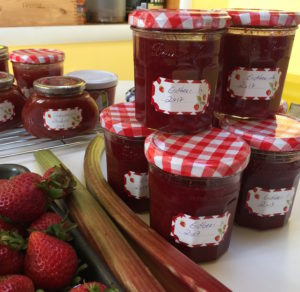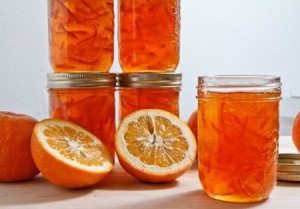Ingredients for 4 Bonne Maman jars of jam
- 2 lb or 900g Strawberry
- 600g sugar
- 1 lemon
This recipe uses no pectin but lemon as a thickener. If you like to make Strawberry-Rhubarb jam just use half strawberries, half rhubarb and add a lemon zest from an additional lemon as rhubarb doesn’t have a lot of pectin. Also, don’t make batches larger then this one as it alters the cooking time and is harder to get it thickened perfectly. Make two or three separate batches if you want to make more jam.
Wash and hull the strawberries and cut them into equal pieces. If you use rhubarb, peel them and cut lengthwise as well as horizontally into equal, 3/4 inch sized pieces.
Put the fruit into a non-reactive blow or a large enameled dutch oven you’ll cook the jam in, cover with sugar, squeeze the lemon and add the lemon halves without the seeds (and additional zest for strawberry-rhubarb jam) to the berries. Stir well and let macerate for 2 – 4 hours.
While the berries are marinating, put a small plate in the freezer to later check if the jam for thickness and sterilize your jars.
There are several ways to sterilize your jars for canning. You can run them through a short cycle on your dishwasher. You can place them in a large pot (12 quart) of water on top of a steaming rack (so they don’t touch the bottom of the pan), and bring the water to a boil for 10 minutes. Or you can rinse out the jars, dry them, and place them, without lids, in a 200°F oven for 10 minutes. Sterilize the lids by letting them sit in just boiled hot water for a few minutes.
Once all sugar dissolved and the fruit released some of it’s juices, transfer it all to a large enameled dutch oven and cook on medium-high heat. Stir occasionally as the strawberries reduce and the juices thicken. About 5 minutes in, remove the lemon halves and use a stick blender to puree the jam as much as you like. This seems to reduce cooking time and therefore makes for a fresher tasting jam. If a lot of foam rises to the surface, skim it away. It’s done when the syrup is the consistency of warm maple syrup – about 10 minutes or so, depending on the pot and berries.
Turn off the heat and put a spoonful of the jam on the frozen plate and return the plate to the freezer. If it wrinkles when you nudge it, it’s done. If not, return the plate to the freezer and cook the jam a little more, testing it again. It may take a few times before you get it to the right consistency.
Use a large ladle to pour the jelly into the sterilized jars to 5/8 inch from the top rim of the jar. If you have one, use a jam filter to pour the jelly into the jar. Quickly close the lid, hold closed jar upside and sit down to let cool. You will hear a popping noise as a vacuum seal is created as the jars of jelly cool. The most rewarding sound after all that work!


